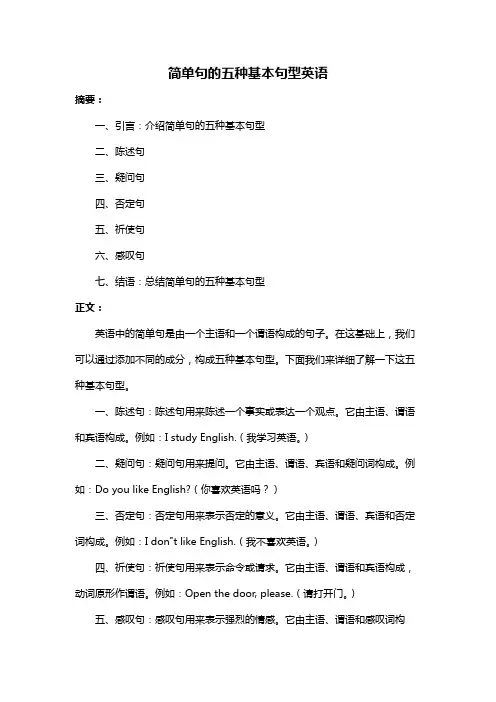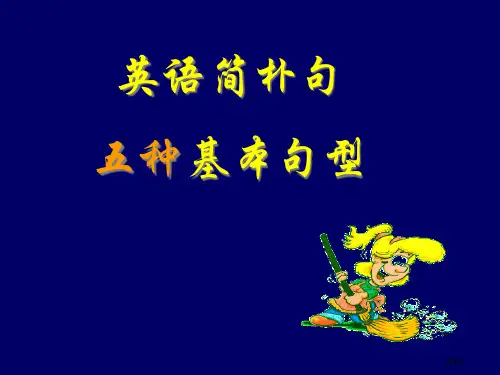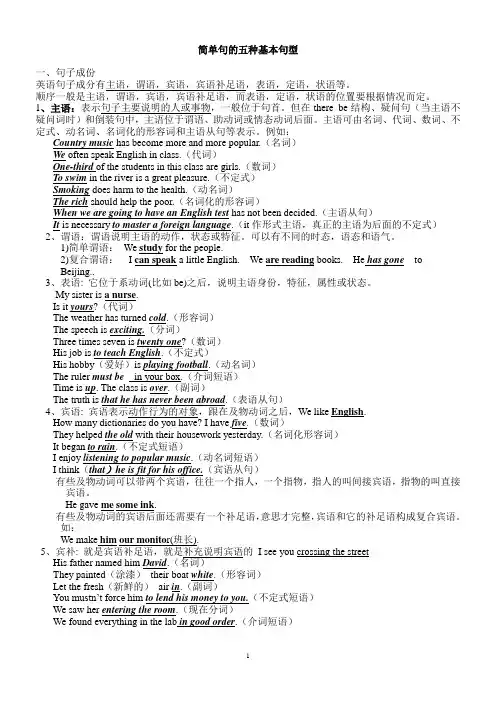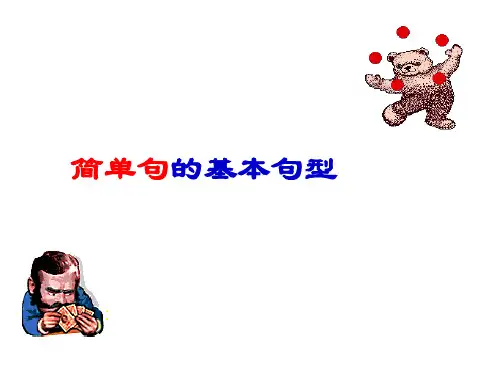英语简单句的五种基本句型(共35张ppt)
简单句的五种基本句型英语

简单句的五种基本句型英语
摘要:
一、引言:介绍简单句的五种基本句型
二、陈述句
三、疑问句
四、否定句
五、祈使句
六、感叹句
七、结语:总结简单句的五种基本句型
正文:
英语中的简单句是由一个主语和一个谓语构成的句子。
在这基础上,我们可以通过添加不同的成分,构成五种基本句型。
下面我们来详细了解一下这五种基本句型。
一、陈述句:陈述句用来陈述一个事实或表达一个观点。
它由主语、谓语和宾语构成。
例如:I study English.(我学习英语。
)
二、疑问句:疑问句用来提问。
它由主语、谓语、宾语和疑问词构成。
例如:Do you like English?(你喜欢英语吗?)
三、否定句:否定句用来表示否定的意义。
它由主语、谓语、宾语和否定词构成。
例如:I don"t like English.(我不喜欢英语。
)
四、祈使句:祈使句用来表示命令或请求。
它由主语、谓语和宾语构成,动词原形作谓语。
例如:Open the door, please.(请打开门。
)
五、感叹句:感叹句用来表示强烈的情感。
它由主语、谓语和感叹词构
成。
例如:What a beautiful day!(多么美好的一天!)
总结起来,简单句的五种基本句型分别为:陈述句、疑问句、否定句、祈使句和感叹句。
英语简单句的五种基本句型市公开课金奖市赛课一等奖课件

• buy/bicycle/next Christmas
• tell/news/the day before yesterday
第23页
练习 1 她给我们唱了一首英文歌曲。 She sang us an English song. 2 我去给你沏点新鲜茶。 I’ll make you some fresh tea. 3 这会省去你诸多麻烦。
第16页
基本句型 三 S +V +O(主+谓+宾)
此句型句子共同特点是谓语 动词都含有实义,都是主语产生 动作,但不能表示完整意思,必 须跟有一个宾语,即动作承受者, 才干使意思完整。这类动词叫做 及物动词。
第17页
S V(实义动词) O(宾语)
1. Who knows
the answer?
2. She laughs at her.
第33页
练习1 1我们把窗框漆成了黄色。 We painted the window frames yellow. 2 她把连衣裙染成淡蓝色。
She dyed her dress light blue. 3 他发觉这工作很故意思。
He found the job quite interesting. 4 什么使你这样气愤?
+直宾) 5.S+V +O +OC(主+谓+宾+
宾补)
第6页
基本句型 一 S+V(主+谓) 此句型句子谓语动词都能表示 完整意思。 这类动词叫做不及物动词,后 面能够跟副词、介词短语、状语 从句等。
第7页
S
1. Time 2. The moon 3. The man 4. We all 5. Everybody 6. I 7. They 8. He 9.He 10.They
高中英语高考英语句子结构分析(共35张PPT)

并列句的分类
1、表示连接两个同等概念,常用and, not only…but also…, neither…nor…, then等连接。 e.g. The teacher’s name is Smith, and the student’s name is John.
2、表示选择,常用的连词有or, either…or…, otherwise等。 e.g. Hurry up, or you’ll miss the train.
He worked hard all his life. (划线部分在 句中作状语,修饰动词worked)
He is a school student in No. 1 Middle School. (划线部分在句中作定语,修饰名 词student)
2) 并列句: 句型:简单句+并列连词+简单句
exam. 6) I like some of you very much. 7)If you study hard, you will pass the exam. 8)He goes to school by bike. 9)Though he is young, he can do it well.
位置 呢?
6、状语:它是修饰动词、形容词、副
词或全句用的。
1) I will go there tomorrow.
2) The meeting will be held in the meeting room. 3)The meat went bad because of the hot
weather. 4)He studies hard to learn English well. 5)He didn’t study hard so that he failed in the
英语简单句的五种基本句型(讲解、练习、打印版)

简单句的五种基本句型一、句子成份英语句子成分有主语,谓语,宾语,宾语补足语,表语,定语,状语等。
顺序一般是主语,谓语,宾语,宾语补足语,而表语,定语,状语的位置要根据情况而定。
1、主语:表示句子主要说明的人或事物,一般位于句首。
但在there be结构、疑问句(当主语不疑问词时)和倒装句中,主语位于谓语、助动词或情态动词后面。
主语可由名词、代词、数词、不定式、动名词、名词化的形容词和主语从句等表示。
例如:Country music has become more and more popular.(名词)We often speak English in class.(代词)One-third of the students in this class are girls.(数词)To swim in the river is a great pleasure.(不定式)Smoking does harm to the health.(动名词)The rich should help the poor.(名词化的形容词)When we are going to have an English test has not been decided.(主语从句)It is necessary to master a foreign language.(it作形式主语,真正的主语为后面的不定式)2、谓语:谓语说明主语的动作,状态或特征。
可以有不同的时态,语态和语气。
1)简单谓语:We study for the people.2)复合谓语:I can speak a little English. We are reading books. He has gone toBeijing..3、表语: 它位于系动词(比如be)之后,说明主语身份,特征,属性或状态。
My sister is a nurse.Is it yours?(代词)The weather has turned cold.(形容词)The speech is exciting.(分词)Three times seven is twenty one?(数词)His job is to teach English.(不定式)His hobby(爱好)is playing football.(动名词)The ruler must be in your box.(介词短语)Time is up. The class is over.(副词)The truth is that he has never been abroad.(表语从句)4、宾语: 宾语表示动作行为的对象,跟在及物动词之后,We like English.How many dictionaries do you have? I have five.(数词)They helped the old with their housework yesterday.(名词化形容词)It began to rain.(不定式短语)I enjoy listening to popular music.(动名词短语)I think(that)he is fit for his office.(宾语从句)有些及物动词可以带两个宾语,往往一个指人,一个指物,指人的叫间接宾语,指物的叫直接宾语。
简单句五大基本句型课件(共36张)

双宾语结构中有两个宾语,判断标准是 可否将两个宾语顺序替换并加介词to/for
1 I feel excited. 主语+ 谓语(系动词) + 表语 2 They are watching TV. 主语+谓语(及)+宾语 3 Many boys are running. 主语+谓语(不及物) 4 He gave Tom a present. 主 +谓 + 间宾+直宾句型 5 I find it interesting. 主 +谓 + 宾+宾补 6 Music sounds beautiful.主语+ 谓语(系动词) + 表语 7 I am a student. 主语+ 谓语(系动词) + 表语 8 She bought a pen for me主. +谓 + 间宾+直宾句型
英语中千变万化的句子归根结底都是由简单句的五 种基本句型组合、扩展、变化而来的,只要把这些基 本句型弄清楚,你就会游刃有余了
→1. S + V 主语+谓语 主谓结构
Vi 不及物动词
1.A golden eagle is flying. 后面没有宾语 2.A crane eats fish.
3.A Swan has
know/find
→1. S + V(lv) + P 主语+ 谓语(系动词) + 表语
be (am is are was were) / seem / keep /…是/好象(似 乎)是/保持
英语简单句的五种基本句型..

四 主语+系动词+表语
1.主语+系动词+形容词 How are you? I’m fine. They kept silent.
2.主语+系动词+名词 He appeared a fool. It sounds a good idea.
3.主语+系动词+副词 Summer is over. 4.主语+系动词+介词短语 The students are in favour of reform. 5.主语+系动词+不定式/动名词 To see is to believe. Seeing is believing. 6.主语+系动词+从句 My opinion is that the plan won’t work.
2. 主语+及物动词+反身代词
Now I will introduce myself. They blamed themselves for the accident.
3. 主语+及物动词+不定式(做宾语) We can’t afford to pay such a price. You must try to improve. 4.主语+及物动词+动名词(做宾语) I prefer standing. I propose resting for half an hour. 5.主语+及物动词+从句 (做宾语) He claimed that he saw the accident. I’ll do what I can.
三 主语+双宾动词+间接宾语 +直接宾语
1.主语+双宾动词+名词/代词+名词
英语五种简单句基本句型
英语五种简单句基本句型英语五种简单句基本句型一.五种简单句基本句型1.“主语+谓语”(即“主谓”句型)这一句型英汉语言结构形式完全相同,说明“某人或某物如何动作”,或者说“某人或某物自身怎样运动”。
例:TheyarrivedinHarbinyesterdaymorning.分析:“they”(主语)“arrived”(谓语)。
2.“主语+谓语+宾语”(即“主谓宾”句型)这一句型英汉语言的结构形式完全相同,用以说明“某人或某物做什么事情”,或者说“某人或某物发出了动作,并且其动作涉及到另一个人或物”。
例:IstudyEnglish.分析:“I”(主语)“study”(谓语动作)“English”(宾语即动作涉及的对象)。
3.“主语+谓语+间接宾语+直接宾语”(即“主谓双宾”句型)这一句型英汉语序结构相同,说明“某人为谁(间接宾语为人)做某事”,或者说“某人或物的运动涉及到两个对象,其中一个间接对象为人,另一个为物”。
例:OurteachertaughtusEnglish.分析:“ourteacher”(主语)“教”(谓语动作)“us”(间接宾语)“English”(直接宾语)。
4.“主语+谓语+宾语+宾语补足语”(即“主谓宾宾补”句型)这一句型说明“某人或某物要求(使、让)某人做什么”或“某人感觉某人或物怎么样”。
例:Heaskedhertogothere.分析:“he”(主语)“asked”(谓语动作)“her”(宾语即动作涉及的对象)“togothere”(补语--补充说明宾语做什么)。
5.“主语+系动词+表语”(即“主系表”句型)这一句型用以说明“某人(某物、某事、某种概念)具有什么特征或处于什么状态”。
汉语的“是”字结构属于这一英语句型的形式之一。
常用的系动词有be,keep,lie,remain,stand,become,fall,get,go,grow,turn,look,feel,see m,smell,sound,taste,等。
英语句子成分及简单句的五种基本句型ppt课件
c. 分词短语 Not knowing what to do I decided to give up.
27
d. 动词不定式短语 His mother often comes to see him.
1. S+V+P 主+系+表
This is an English dictionary. The dinner smells good. The well has gone dry. He is growing tall and strong.
34
英语co五nt种en基t 本句型
2. S+V 分的功能
四、 表语:
表语主要用于表述主语的特征,状态,身份 等。它位于_连__系__动__词__后,构成系表结构。
17
各个成分的功能
表Ad示d状yo态ur title
系动词
be
A一dd直yo保ur持title
keep, remain,stay
看A起dd来yo,ur似tit乎le
seem, appear
The sun was shinning.
We all breathe, eat and drink.
His parents have worked in the factory for more than 10 years.
35
英语五co种nt基en本t 句型
3. S+V+O 主+谓(及物动词)+宾
感Ad官d系yo动ur词title look, sound, smell , taste, feel
become, turn ,fall, grow, get,
英语简单句的五种基本句型
英语简单句的五种基本句型只包含一个主语(或并列主语)和一个谓语(或并列谓语)的句子,称作简单句。
简单句有以下5种基本句型。
1、S主+Vi不及物:Wecome我们来;2、S主+V系+P表:Classisover下课了;3、S主+Vt及物+O宾:Shehateshim她恨他;4、S主+Vt及物+IO间宾+DO直宾:Shegavemeanewbook.他给了我一本新书;5、S主+Vt及物+O宾+OC宾补:WenamedourbabyTom.我们给孩子取名汤姆。
5种基本句型用法详解1、主+谓=S+Vi(主+不及物动词)主语:可以作主语的成分有名词,主格代词,动词不定式,动名词等等。
主语一般在句首。
谓语:谓语由动词构成,是英语时态、语态变化的主角,一般在主语之后。
不及物动词(vi.)没有宾语,形成主谓结构,如:S(主)+Vi(不及物动词)(谓语)Thebabycried.婴儿哭了Wecome.我们来1)S+Vi+副词(状语)eg:Birdssingbeautifully.2)S+Vi+介词短语(状语)eg:Hewentonholiday.3)S+Vi+不定式(状语)eg:Westoppedtohavearest.4)S+Vi+分词(状语)eg:I'llgoswimming.此句型的句子有一个共同特点:即句子的谓语动词都能表达完整的意思。
这类动词叫做不及物动词,后面可以跟副词、介词短语、状语从句等。
2、S+V系+P(主+系+表)此句型的句子有一个共同的特点:句子谓语动词都不能表达一个完整的意思,必须加上一个表明主语身份或状态的表语构成复合谓语,才能表达完整的意思。
这类动词叫做连系动词。
表语也就是主语的补足语ThisisanEnglish-Chinesedictionary.Thedinnersmellsgood.Heisgrowingtallandstrong.1)S+V+名词/代词eg:Heisaboy.2)S+V+形容词eg:Sheisbeautiful.3)S+V+副词eg:Classisover.4)S+V+介词短语eg:Heisingoodhealth.5)S+V+分词eg:Heisexcited.3、S+Vt+O(主+及物+宾)此句型句子的共同特点是:谓语动词都具有实义,都是主语产生的动作,但不能表达完整的意思,必须跟有一个宾语,动作的承受者,才能使意思完整。
高中英语简单句五种基本句型_ PPT课件 图文
We found the great hall full of students and
teachers listening to an important report m__a_d_e__b_y_a__c_o_m_r_a_d_e_ from the People's Daily on
基本句型一:S +V
(主+谓)
基本句型二:S +V +P (主+谓/系+表)
基本句型三:S +V +O (主+谓+宾)
基本句型四: S +V +InO +DO(主+谓+间宾+直宾)
基本句型五: S +V +O +OC(主+谓+宾+宾补)
各种词类及其在句子中的作用:
1. Nouns (n.) 名词:
e.g. We like th.她经常帮她妈妈。
She often helps
2. 我想要一杯茶。
I
want
O her mother. a cup of tea.
基本句型 四
S +V +InO +DO(主+谓+间宾+直宾)
特点:谓语动词必须跟有两个宾语才能表达完 整的意思。这两个宾语一个是动作的直 接承受者,另一个是动作的间接承受者。 通常可改为
S
between about AD 450 and 1150)was very
At.(定语)
V
different from the English(spoken today).
- 1、下载文档前请自行甄别文档内容的完整性,平台不提供额外的编辑、内容补充、找答案等附加服务。
- 2、"仅部分预览"的文档,不可在线预览部分如存在完整性等问题,可反馈申请退款(可完整预览的文档不适用该条件!)。
- 3、如文档侵犯您的权益,请联系客服反馈,我们会尽快为您处理(人工客服工作时间:9:00-18:30)。
3. 宾语 ( Object )
常指及物动词或介词后面使之意思完整的词或短语。 常由名词、代词、动词不定式或doing短语等充当。 例如: 1. She has finished doing the experiment. 2. We like English and are good at it.
past thirty years.所发生的事情— 变化)
2. 谓语 ( Predicate )
说明主语“做什么” “是什么” 或 “怎么样”。 通常由动词或动词短语结合时态、语态、语气等充当。 要弄清两个概念: 及物动词:后面直接接宾语的动词; 不及物动词:后面不能直接接宾语的动词。
例如: 1. Children like playing games. 2. They were talking about a new film.
7. 宾语补足语 ( Object Complement )
常指补充说明宾语的成分,逻辑上与宾语是“主谓” 关系。常由形容词、名词、介词短语、动词不定式 或分词短语等充当。
例如: 1. She keeps the house clean every day. 2. Nobody calls me a liar. 3. We last saw him playing on the playground.
02知识梳理
五种基本句型
1. 主语+不及物动词 Everybody smiled. 2. 主语+及物动词+宾语 He knows everything. 3. 主语+双宾动词+间接宾语+直接宾语 I showed him my passport. 4. 主语+系动词+表语 The boy looks healthy. 5. 主语+及物动词+宾语+宾语补语 What made you angry?
3. 主语+不及物动词+副词(构成成语动词) The engine broke down. How did the accident come about? The bomb blew up.
4.主语+不及物动词(有被动意思) Is the book selling well? Does this cloth waive )
与系动词连用,一起构成谓语,说明主语的性质特征等。 常由名词、代词、形容词、数词、短语或从句等充当。 英语中常见的连系动词有: look; sound; feel; seem等。 例如: 1. Her grandfather is an engineer. 2. The two countries were at war then. 3. The fact seems that he didn’t notice the car.
5.主语+及物动词+从句 (做宾语) He claimed that he saw the accident. I suggested (that) we (should) leave early. Do you see why I did it? She asked if she might call and see me. I’ll do what I can. I don’t remember when that happened.
5. 定语 ( Attributive )
常指修饰名词的词或短语。 常由形容词、形容词性物主代词、名词、数词、副词、 介词短语、动词不定式或分词短语等充当。 例如: 1. The black sweater is mine. 2. We have eight classes every day. 3. The coffee cup on the table is mine.
二 主语+及物动词+宾语
1.主语+及物动词+名词(代词)
Do you know them? He loved ice-cream.
2. 主语+及物动词+反身代词 Now I will introduce myself. They blamed themselves for the accident.
英语的基本句型
01课堂导入
课堂导入
什么叫简单句?
想一下?
有主语!
有谓语!
有形容词!
02知识梳理
1. 主语 ( Subject )
表示句子说的是“什么人” 或 “什么事”。 通常由名词、代词、主语从句或doing短语等充当。 例如: 1. My teacher hates telling lies. (指老师这个人) 2. Great changes have taken place in China in the
祈使句的主语一般都省略掉
一 主语+不及物动词
1.主语+不及物动词 The sun is rising. It will snow. Can you fly?
2.主语+不及物动词+状语 Did you sleep well? She often dreams. You go first and I will follow behind.
3. 主语+及物动词+不定式(做宾语) We can’t afford to pay such a price. You must try to improve. He forgot which way to go.
4.主语+及物动词+doing(做宾语) Would you mind waiting for a few minutes? I prefer standing. I propose resting for half an hour.
6. 状语 ( Adverbial )
常指修饰动词、形容词或副词的成分,修饰动词时 表示动作发生的时间、地点、目的或方式等;修饰 形容词或副词时表示它们的程度等。状语常由副词、 介词短语、动词不定式或分词短语等充当。 例如: 1. The miners work very hard. 2. She often helps Mike at school. 3. Hearing the news, he couldn’t help jumping.
